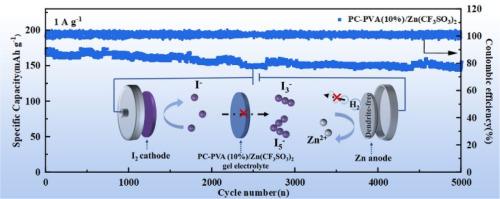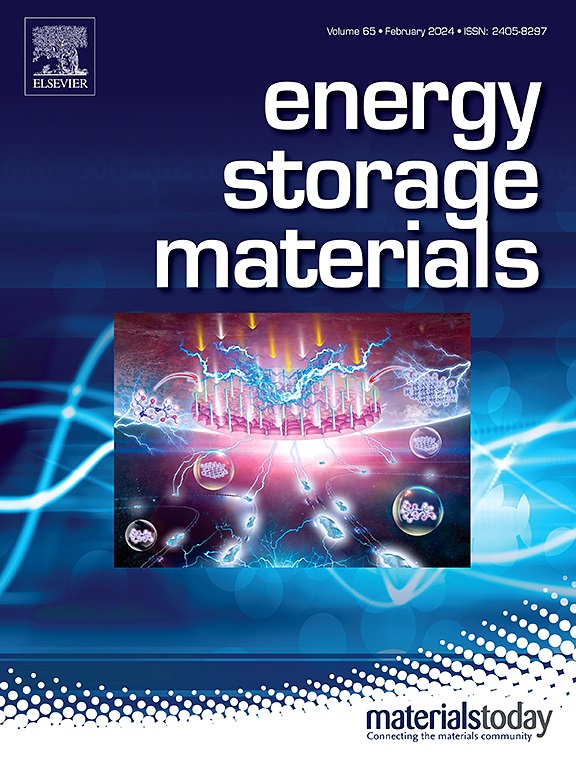A novel water-reducer-based hydrogel electrolyte for robust and flexible Zn-I2 battery
IF 20.2
1区 材料科学
Q1 CHEMISTRY, PHYSICAL
引用次数: 0
Abstract
Aqueous zinc-iodine (Zn-I2) batteries are becoming increasingly attractive due to their considerable capacity, inherent safety and economic viability. However, the key issues remain unsolved including the shuttling of polyiodides in the I2 cathode and the severe corrosion and dendrite growth in the zinc anode. This work propose a novel water reducer-based gel electrolyte, PC-PVA/Zn(CF3SO3)2, to concurrently handle with Zn anode and I2 cathode. Specifically, the hydrogen evolution corrosion for the Zn anode is effectively inhibited by forming hydrogen bonds to lock free H2O molecules and the dendrite growth of the Zn anode could be hindered by adjusting the electric filed to realize the homogenous Zn2+ deposition. Simultaneously, the abundant polar oxygen-containing group in PC-PVA gel can capture polyiodide and mitigate the “shuttle effect”, thereby enhancing the I2/I− redox kinetics. This hydrogel electrolyte with excellent mechanical properties also gives rise to the electrode's high stability. As a result, such a PC-PVA/Zn(CF3SO3)2 electrolyte enables Zn anode with an excellent lifespan over 4000 cycles and at 1 mA cm−2, 1 mAh cm−2, and the average coulombic efficiency could attain 99.4%. And the resulting Zn||I2 full cells also demonstrate excellent performances, which the reversible capacity could maintain at 155.2 mAh g−1 after 5000 cycles at 1 A g−1, and the capacity decay rate is only 0.0015% per cycle. This cost-effective and readily available gel electrolyte provides a viable strategy for commercializing Zn-I2 batteries.

一种新型的还原剂基水凝胶电解质,用于坚固和柔性的锌- i2电池
锌-碘(Zn-I2)水电池由于其相当大的容量、固有的安全性和经济可行性而变得越来越有吸引力。然而,I2阴极中多碘化物的穿梭和锌阳极中严重的腐蚀和枝晶生长等关键问题仍未得到解决。本文提出了一种新型的基于减水剂的凝胶电解质PC-PVA/Zn(CF3SO3)2,用于同时处理Zn阳极和I2阴极。其中,通过形成氢键锁住游离的H2O分子,可以有效抑制Zn阳极的析氢腐蚀;通过调节电场,实现Zn2+的均匀沉积,可以抑制Zn阳极的枝晶生长。同时,PC-PVA凝胶中丰富的极性含氧基团可以捕获多碘化物,减轻“穿梭效应”,从而提高I2/I−氧化还原动力学。这种具有优异机械性能的水凝胶电解质也使电极具有较高的稳定性。结果表明,这种PC-PVA/Zn(CF3SO3)2电解质使Zn阳极在1 mA cm - 2和1 mAh cm - 2下具有超过4000次循环的优异寿命,平均库仑效率可达到99.4%。所得的Zn||I2全电池也表现出优异的性能,在1 A g−1下循环5000次后,其可逆容量可保持在155.2 mAh g−1,且每循环的容量衰减率仅为0.0015%。这种具有成本效益且易于获得的凝胶电解质为锌- i2电池的商业化提供了可行的策略。
本文章由计算机程序翻译,如有差异,请以英文原文为准。
求助全文
约1分钟内获得全文
求助全文
来源期刊

Energy Storage Materials
Materials Science-General Materials Science
CiteScore
33.00
自引率
5.90%
发文量
652
审稿时长
27 days
期刊介绍:
Energy Storage Materials is a global interdisciplinary journal dedicated to sharing scientific and technological advancements in materials and devices for advanced energy storage and related energy conversion, such as in metal-O2 batteries. The journal features comprehensive research articles, including full papers and short communications, as well as authoritative feature articles and reviews by leading experts in the field.
Energy Storage Materials covers a wide range of topics, including the synthesis, fabrication, structure, properties, performance, and technological applications of energy storage materials. Additionally, the journal explores strategies, policies, and developments in the field of energy storage materials and devices for sustainable energy.
Published papers are selected based on their scientific and technological significance, their ability to provide valuable new knowledge, and their relevance to the international research community.
 求助内容:
求助内容: 应助结果提醒方式:
应助结果提醒方式:


